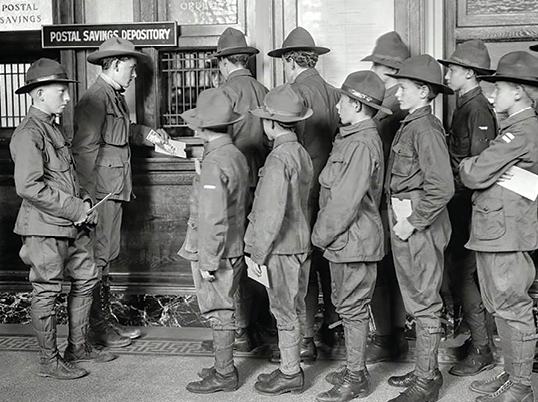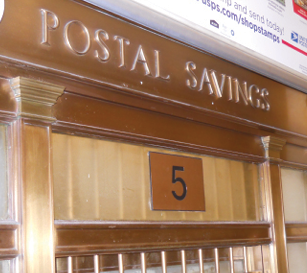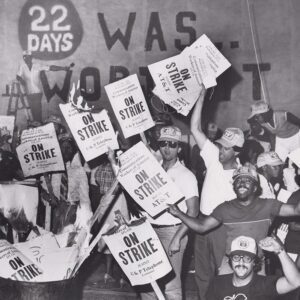April 30, 2016
The U.S. Post Office: The Workers’ Savings Bank

Once upon a time, in a not-so-far-away land, working people were able to safely deposit and withdraw their hard-earned dollars, with no excessive fees or fuss. Everyone had access to safe savings accounts, regardless of how much money they
made or where they lived.
That not-so-far-away land is the United States, when, from 1910 to 1966, the United States Postal Savings System (USPSS) safeguarded more than a million accounts, most of them owned by workers and recent immigrants.
“In an age of corporate megabanks with trillions of dollars in assets, it is easy to forget that America’s banking system was originally created as a public service,” writes University of Georgia Professor Mehrsa Baradaran, in her book, How the Other Half Banks. “Postal banking can provide small loans to the creditworthy among the low- and middle-income without life-crushing fees and interest.”
Today, 68 million Americans are “underserved” by the private banking system. Traditional banks are fleeing low-income communities, including rural and inner-city areas, putting many residents at the mercy of predatory payday lenders, who push them further into debt.
But it doesn’t have to be this way.
In 2014, the USPS Office of Inspector General (OIG) published a report urging postal management to revive postal banking. Since there is a post office in nearly every zip code, everyone would have access to basic financial services – without exorbitant fees and red tape.
Postal banking was successful in the past – and can be again.

An Instant Success
Postal banking started in Great Britain in 1861. Ten years later, President Grant’s Postmaster General, John Creswell, proposed American postal savings banks, modeled after those across the Atlantic.
Grant saw the idea as a way to include remote regions in the nation’s financial structure, but it took several decades to get the postal savings system off the ground. On Jan. 31, 1910, Sen. Thomas Carter (R-MT) proposed a postal savings bill, which President Taft signed into law six months later.
Postal savings accounts were an instant hit. By the end of 1910, there were $20 million in deposits. By the end of 1913, the New York Times reported that with $33 million in deposits, postal banks were “self-sustaining.”
Service for All
Postal savings branches strived to provide service for all. Information was available to customers in 24 languages, and local postmasters were given phrase books in different languages to allow clerks to conduct business with non-English speakers.
During the Wilson administration, the post office launched a promotional campaign using foreign-language newspapers to advertise postal savings accounts.
By 1915, immigrants made up 60 percent of the depositors and owned over 75 percent of the bank’s deposits, even though they made up less than 15 percent of the population.
Saving the Economy
After the stock market crashed in 1929, many more people grew wary of traditional banks and turned to the postal savings system. In 1930, 50,000 new accounts were established and deposits totaled $191 million. The numbers doubled every year for the next three years.
A 2013 analysis by the Yale Journal of Economics shows that the postal savings system reduced bank failures during the Great Depression by infusing liquidity into local banks and providing a safe haven for deposits.
Through 1935, in the midst of the Great Depression, President Franklin D. Roosevelt allowed post offices to sell Postal Savings Bonds, and eventually Treasury Bonds.
‘The Safest Thing Possible’
Retired APWU member James Lynch served as a clerk and letter carrier from 1958 to 1989, in Alameda, CA. As a window clerk in the 1950s and 60s, he handled countless postal savings account transactions.
“The people who used postal banking services were completely across the economic scale,” Lynch said.
But it especially helped the working poor. “It really helped people who had a minimum amount of money,” he said, noting that just like today, a certain amount of money is required to open a bank account.

today at the Lenox Hill Post Office in Manhattan.
Peak and Fall
Postal deposits reached their peak in 1947, with 4 million users and $3.4 billion in deposits. In the 1940s, USPSS introduced banking by mail, resulting in an influx of deposits. In addition, servicemen abroad deposited their earnings in postal accounts.
By the end of World War II, the government raised $8 billion in additional war funding though Savings Bonds and Treasury Bonds sold through the post office.
With the economic boom of the 1950s, however, banks moved to destroy the Postal Savings System. In 1952, a study requested by Wallace Bennett, who served on the Senate Banking Committee and was known for his support for the traditional private banking industry, concluded that USPSS was no longer justified.
A second government study followed, and bills were soon introduced to dismantle the system.
Because Congress capped the interest rates for postal savings accounts, private banks could woo their customers. And, thanks to the creation of the Federal Deposit Insurance Corporation (FDIC), private bank accounts were deemed just as safe as postal savings accounts. Deposits flowed out of the public Postal Savings System to traditional accounts at a rate of a 10 percent per year for three years starting in 1950.
In 1966, with fewer than a million account owners, the USPSS was officially abolished as part of President Lyndon Johnson’s effort to “streamline” the federal government. The only opposition came from the United Federation of Postal Clerks and the National Postal Union – who would join with three other postal unions in 1971 to form the American Postal Workers Union.
Revival
In the wake of the Great Recession, activists are calling for the expansion of financial services, including postal savings accounts.
Sen. Bernie Sanders (I-VT) and Sen. Elizabeth Warren (D-MA) have endorsed the idea. The Campaign for Postal Banking (see p. 12), launched in 2015, delivered over 150,000 signatures to the Postal Service in December, calling on the USPS to “Implement Postal Banking Now!”
Lynch is also on board. “When I think of the Postal Service today, I see a Board of Governors that is gradually taking away services. When they take away rather than build, they are putting a bad light on the service I am proud I served in. The postal banking system is very good for both the public and the Postal Service.”



